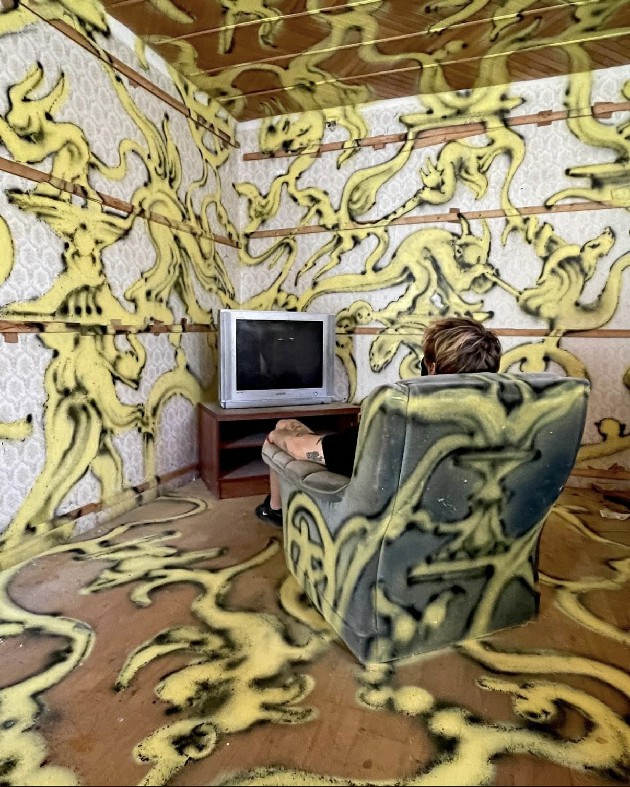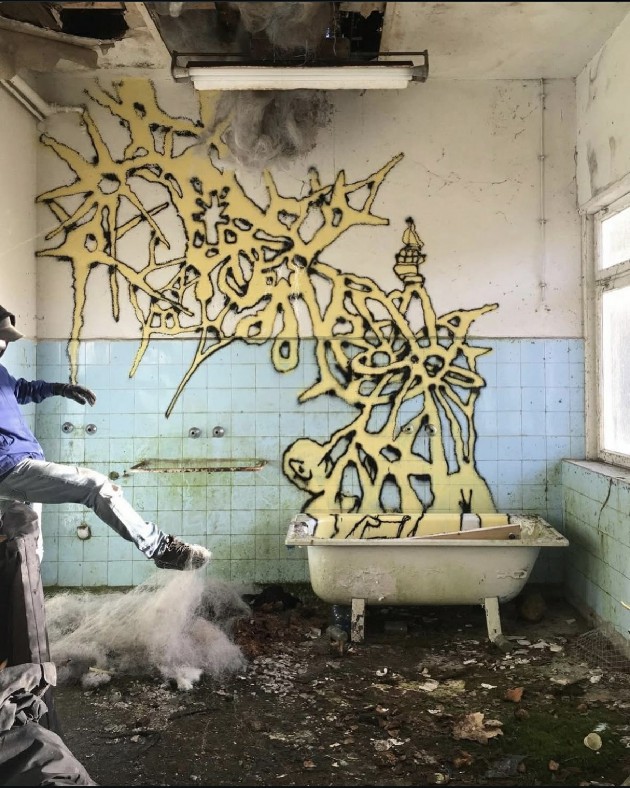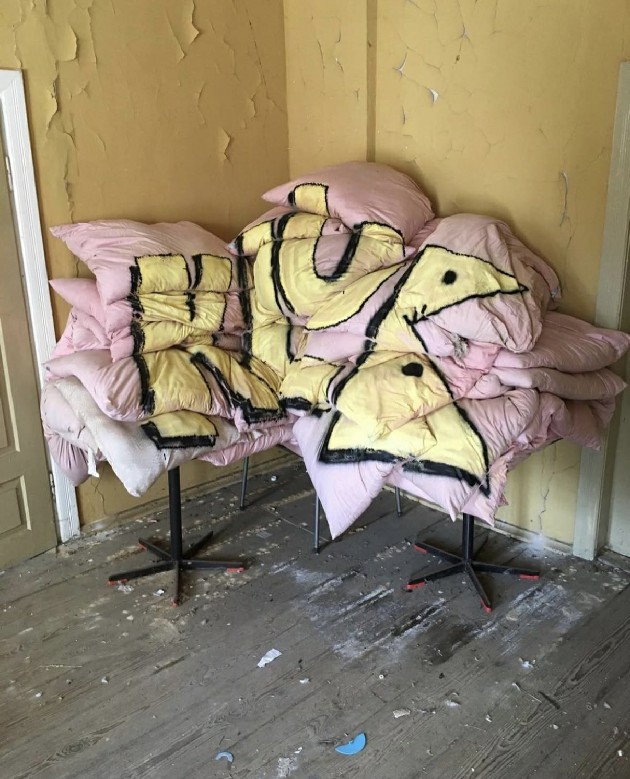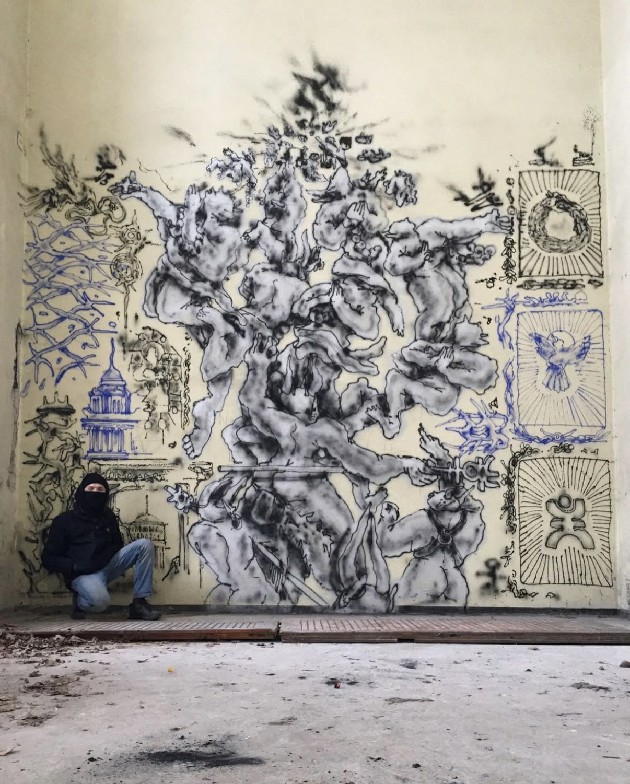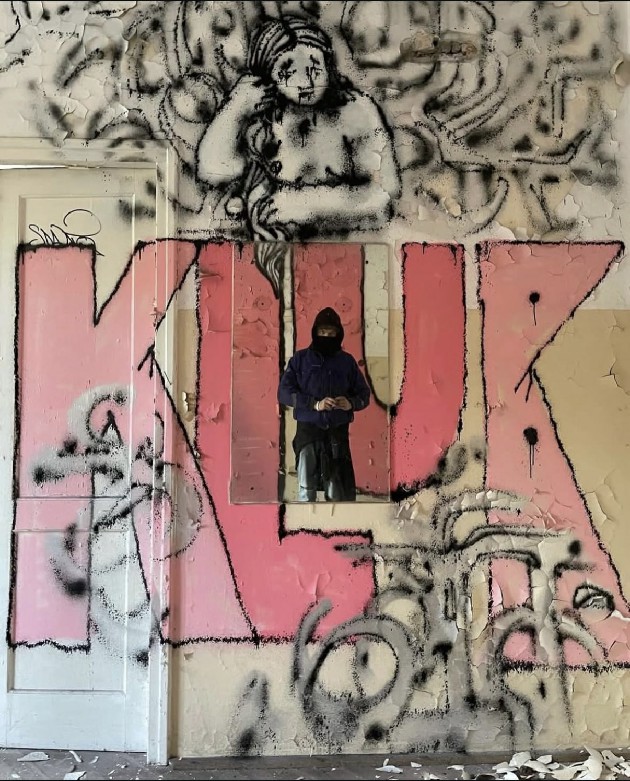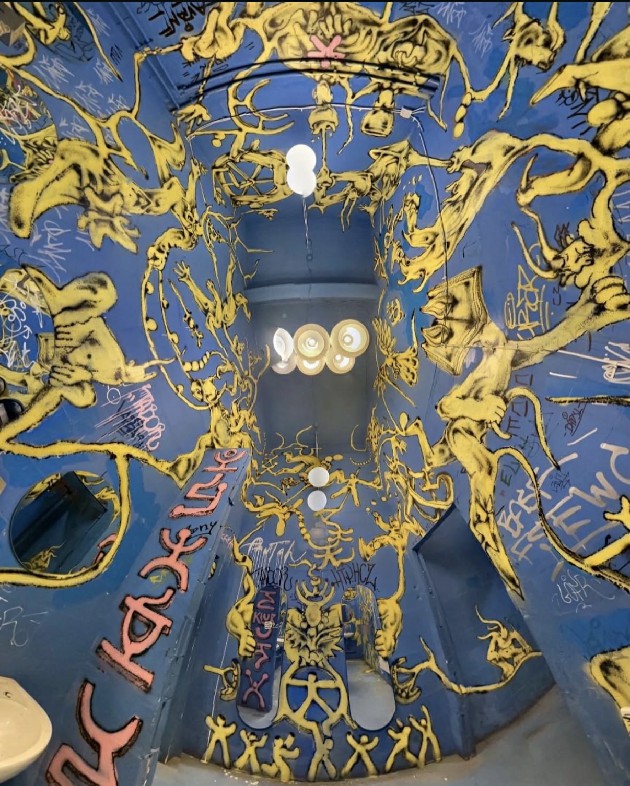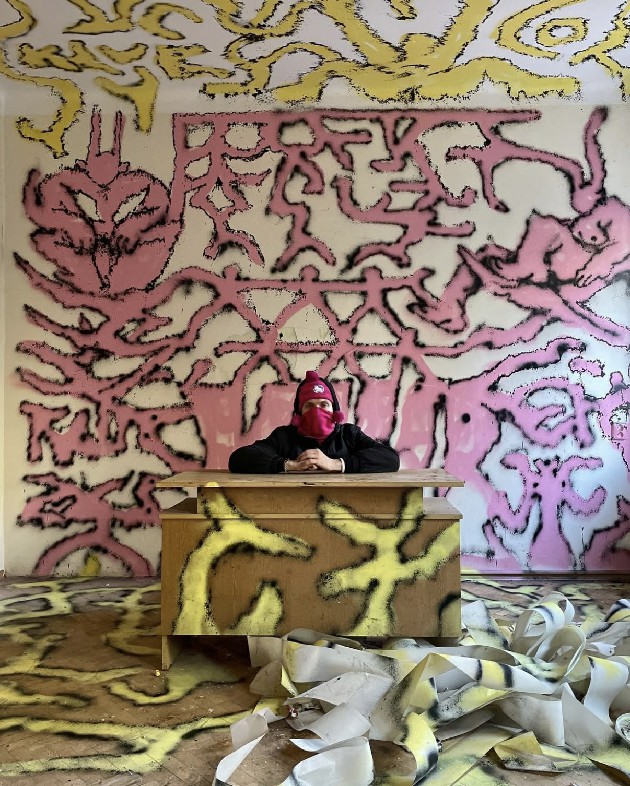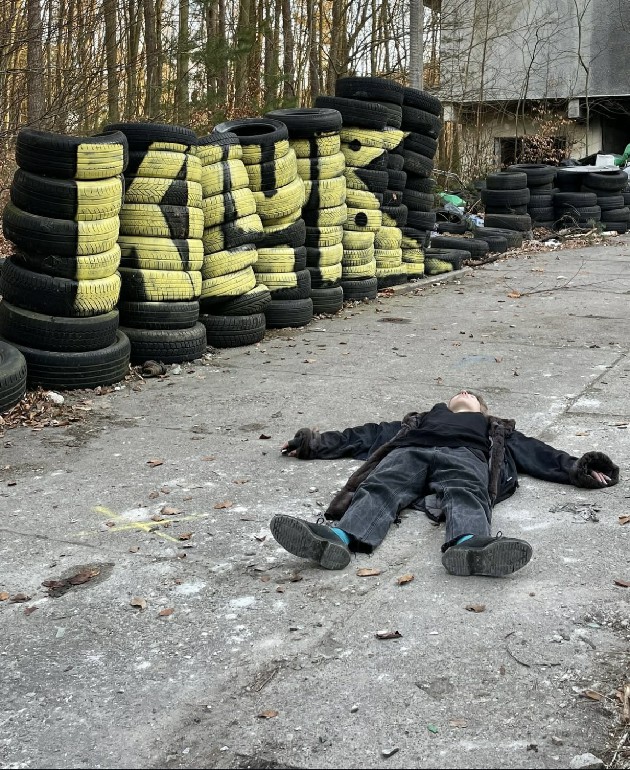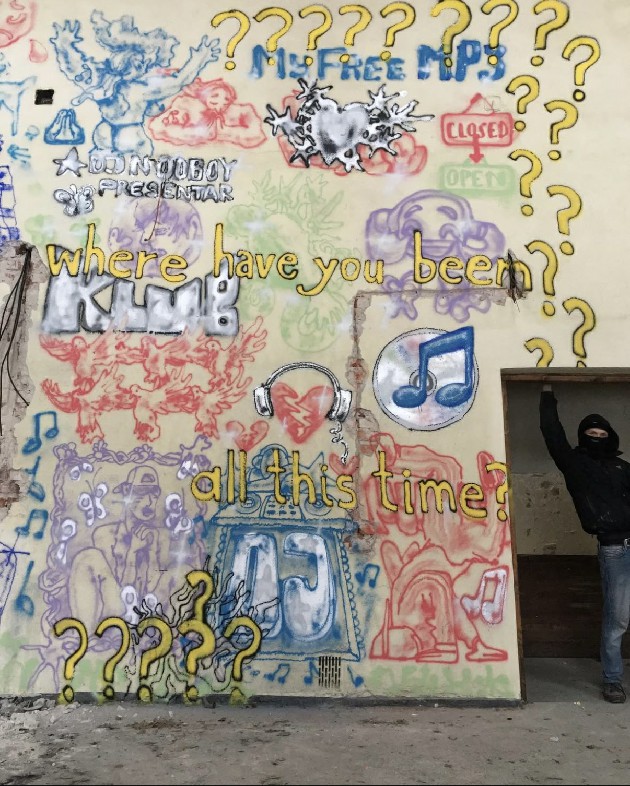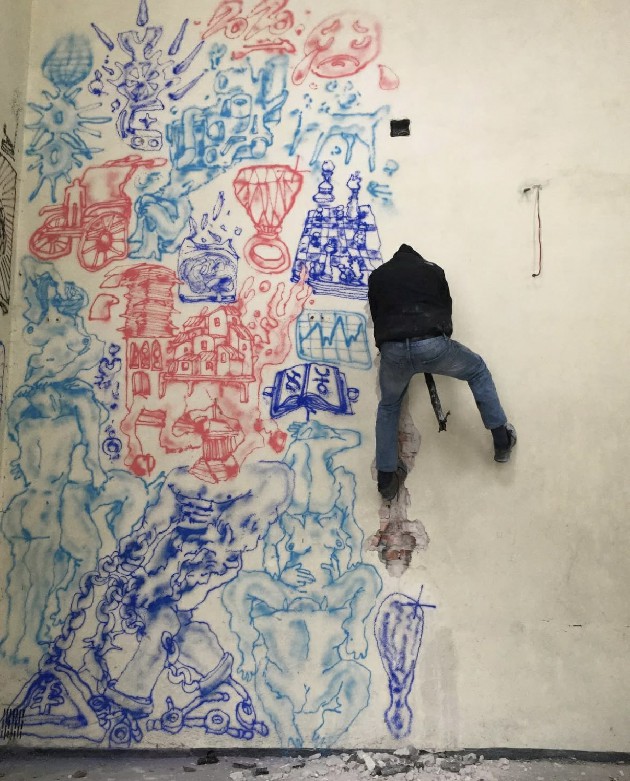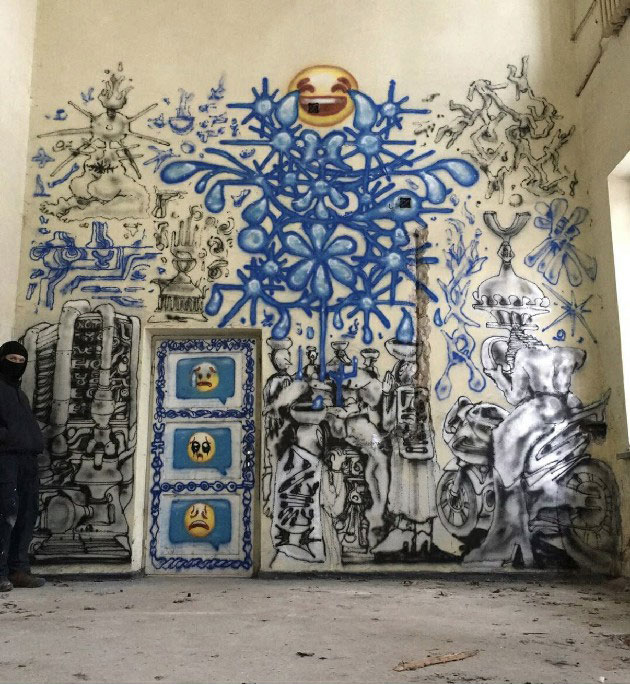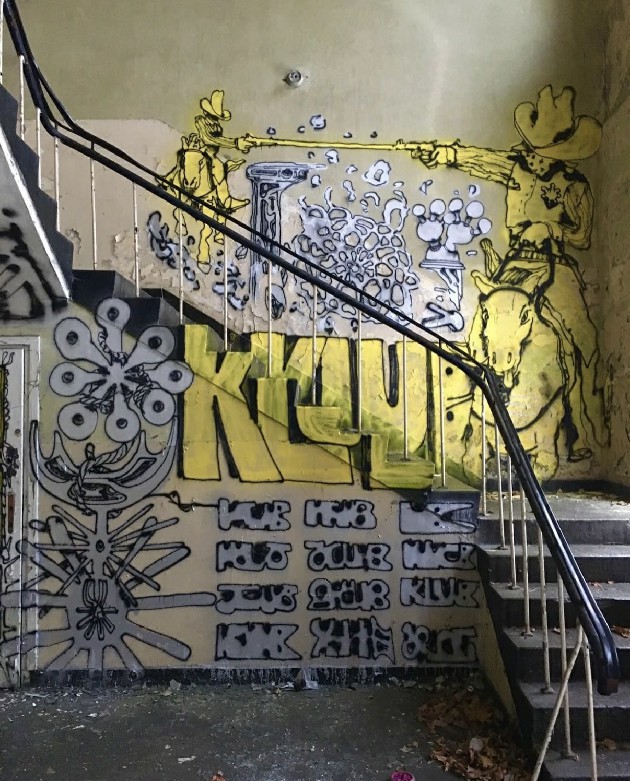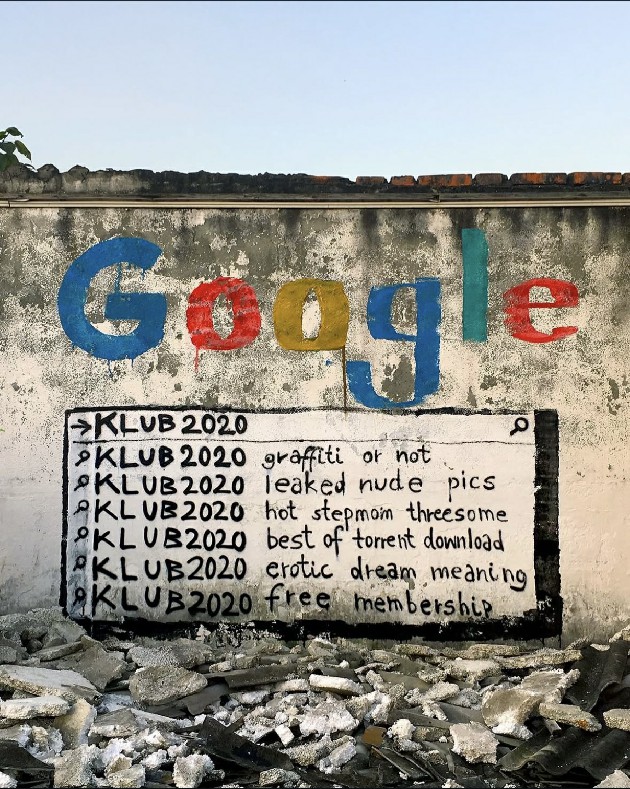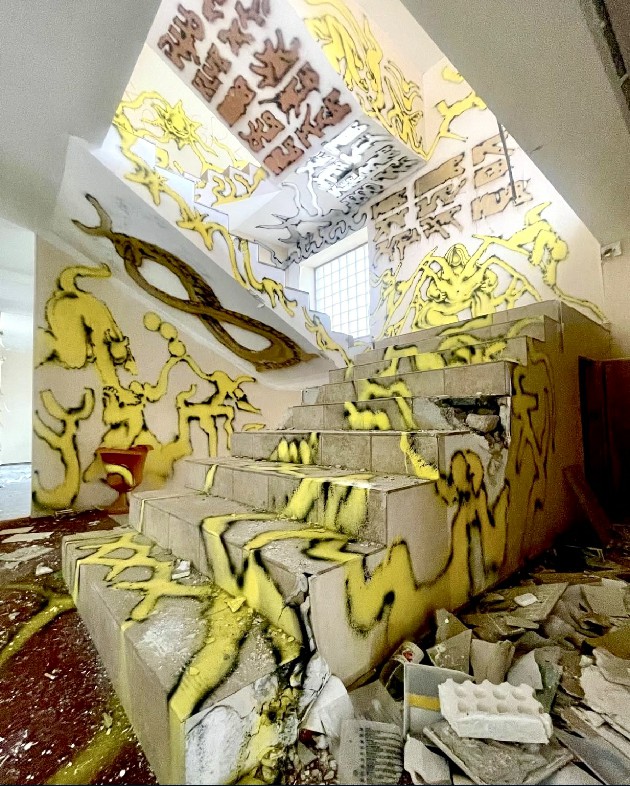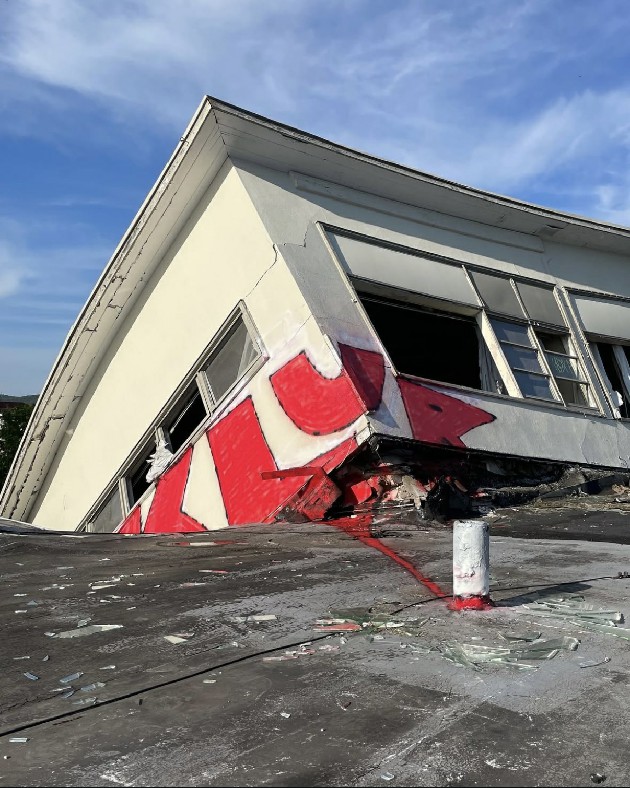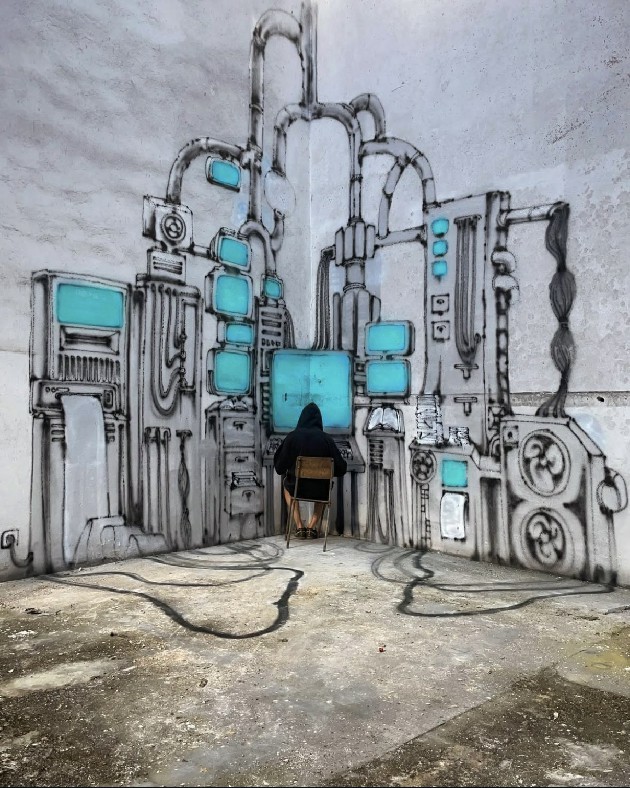Graffiti-Post-Architecture
Talking with Klub2020
An Interview by Clara Joy
April 18th, 2025, NYC
by Clara Joy
1. Where does the name Klub2020 come from, and what does it represent for you?
Klub2020: The earliest memory: from my window, the deep, solemn, massive street. The afterimage of love, now fading away, confusing the body and the spirit into a politics of absorption—a solitary mission to absorb the sadness at first, and then to absorb the fresh ocean breeze whisking through the porthole slit. The house was enormous; it could shack up twelve people, mostly students, spread across tiny rooms and basements, with three bathrooms to share, all connected by a spiral staircase of dark wood held together by a threadbare Portuguese runner.
First of all, the house was inhabited by loneliness, which manifested in forking paths, doors shut, and night visitors quietly creeping down the stairs. On some days, we could feel as though we were one with the house—a subjectivity split into twelve, a personality, an outfit, and a patchwork of wisdom catered to each month, a dividual by necessity, not by choice – a fortune told backward and upside down yet focused and sharp, as if seen with perfect, clear vision, a tale told in reverse—just like the oranges, falling upwards from a tree in the backyard—a sight utmost queer, to say the least!
2. How did you first get into graffiti, and how has that background influenced your current work?
Klub2020: During the whole of a dull, dark, and soundless day, I was reading and staring out of the window, until a scream and a commotion shattered the ordinary silence. And a dozen but one doors opened, and out came noses, eyebrows, and startled, curious eyes. At the bottom of the stairs lay a body—lifeless. The body was being examined by a doctor, a policeman, and the lady of the house, who usually appeared only to chat with her favorite dweller, a young boy named Pedro Páramo. But today, the lady was summoned by history. She looked up the stairs and screamed: poisoned!
The house carried a mystery. It was the anti-House of Leaves, shrinking on the inside, its walls contracting around already tiny rooms in perfect proportion to the lonesome growth of our inner lives. Living there was cursed, and the body was but proof of that. We all knew it before, yet left with no other choice we came in peace, hoping to bring life into rooms of antique, half-ruined furniture. It was unknown to us whether the obscure writings on its fence or the sequences of numbers on basement walls had sealed this fate; maybe it was us who had brought doom upon the mansion.
Yet there was something fascinating in that mystery. In the illegible inscriptions left by an unkown hand, for an unknown reason.
3. What led you to this type of work? How did your style develop over time? Was there a turning point that shaped your direction?
Klub2020: The victim brought us all together, even if only for a short while. Many faces, previously veiled in shadows, were silently acknowledged. I remember the awkwardness and the warmth of mutual recognition—the desire to be liked, or at least seen, the need that anchors in a group those who, upon losing keys or credit cards, feel the urge to leave society.
The bodies gathered and realized: there is an event. An event is happening, and it is happening within the confines of the house. The mode of thinking begins to shift toward the pragmatic. Information is being quietly reviewed; everyone wants to be of use, hoping that a contribution will clear them of any suspicion, a task bordering on impossible in a house of distrust.
The event transforms the crowd. A thus far unwilling audience of one to an interminable home movie that documents one’s failings becomes transformed into carriers of contribution—perceived and important, even if only for a short while.
The solemn house fills with the scent of excitement, and the oranges fall upwards like never before.
The policeman raises a finger and announces: “The murder came with a riddle.”
The policeman raises a finger and announces: “The murder came with a riddle.”
4. Your work often transforms entire spaces into immersive environments. Can you walk us through your process? What draws you to filling an entire room rather than working on a single canvas or wall?
Klub2020: Pedro Costa’s Colossal Youth proves a point made in Bewes’s Free Indirect —it gives birth to a thought that emerges from tradition but surpasses the constraints of subject and object, becoming an entity in itself, an egregore. Every love story is a ghost story, just as every film about ghosts is a film about exile.
The first question is: how to transform an unwilling audience into a willing one?
Costa’s transcendent thought manifests in the austere interiors of his films—whether in the raw concrete of the ghetto or the empty, soulless walls of social housing. Shadows of the past haunt buildings now abandoned; the presence of humanity lingers in rooms left to grow moss and mold, scavenged for copper by the miserable.
The second question is: how to make an artwork that is both deep and entertaining?
To stay in such a building is to make peace with the ghosts of the displaced. The solitude of voluntary exile finds comfort in the graveyard of homes. The spirits help to transcend thought itself, transform the intangible into something powerful enough to reside in the collective realm.This seems to be the alchemic process of content and the answer to both questions.
The spirits must be thanked; the houses lost and forgotten become decorated in patterns of their liking.
5. Do you prefer working in certain types of spaces over others? What kind of environments best complement your work?
Klub2020: The body rests at the bottom of the stairs, poisoned to death, and the silence is thick, woven around sconces illuminating the hall. The policeman says:
My fear is not of solitude,
But that this fate is absolute.
A deeper horror, cold and still,
This world alone, forever real.
What am I?
But that this fate is absolute.
A deeper horror, cold and still,
This world alone, forever real.
What am I?
The tenants now see that the body belongs to Pedro Páramo—the housemaster’s favorite. The lodgers are shaken with sadness and terror, yet they cannot help but recall his tyrannical rules: the restrictions on noise, the regulations governing the common area, the order imposed in the backyard. How he desperately locked his kitchen cabinet to prevent theft of produce, casting distrust onto the already fragile ember of community in the house of skulking shadows.
He sold his soul to please the housemaster, from which came authority and abuse—mind that dear Pedro was no more than nineteen years old. He was a victim of the enjoyment of power, a deadly sickness of the young. That was the problem of complicity, something we all contemplated privately upon moving in and reading the rooms. Complicity in the environment.
To live in a house is to respect its rules. To try to rule the house is to enter an exchange with its owner. The privacy of obedience and quiet living was a choice we made to keep our consciences clear, steering ourselves away from the market of influence.
In a way, choosing an austere room over the master bedroom was a way of choosing independence over control, a means of protecting oneself from the futile task of preventing the tragedy of the commons—for there were no commons. Except for Pedro’s kitchen cabinet, which was often raided out of malice.
6. Your style has a connection to graffiti, but do you see your work as fitting within traditional graffiti culture? Or do you view it as something separate?
Klub2020: The riddle stuck with us for a while as the doctor prepared to examine Pedro Páramo.
It reflected the underlying fear of the lodgers, the very substance of the house. The subject was not solipsism, as the first line suggested, but something more serious and grave: an ontological dread. If solipsism was about the equality of looking into someone’s eyes and looking at someone’s eyes, then the riddle suggested something far worse—that there were no other ways to look. Or rather, no reality where a difference was possible.
It was a sentence of a singular fate—a world beyond our understanding, with no alternatives but to quietly orbit a dying star.
If you think about it too much, you might lose your mind – I remember a voice warning me in a free indirect, lexically violating my headspace. I have no choice but to surrender and participate. I choose the advancement of culture. The lodgers quietly agree with me.
Klub2020: In the face of an ontological dread, the only solution seems to be abandoning the distance and producing new realities. The introduction of novelty is the best distraction from absolute factuality—the traumatic core of the puzzle.
We start a conversation and become fully absorbed. Some walk up the stairs and return with their recent projects: little blue books they had been working on, marine watercolors clipped together in bundles, collections of stamps and stickers kept in pristine condition. The question remains unanswered – but sometimes, that’s how it must be.
The doctor bends over Pedro and examines his neck. Soon, he finds something hard pressing against the walls of his throat. He puts his gloved hand deep into his mouth. Baffled, he pulls out a key to the kitchen cabinet.
This goes unnoticed by the lodgers, who are lost in the chatter.
7. Who are some artists or movements that have influenced your approach?
I do post with little to no caption, which alienates the audience, but the alienation seems almost desired. Raw-dogging the feed and visual autofiction.
I do paint myself next to the wall, indulge in cryptic narratives bordering on a joke. I am not interested in formal experiments much further than the context, the message and the scale, as I was never a student of the image, but of the word.
Some images work only on the wall, as the wall’s canvas is infinite. It stretches beyond the frame of the photo. The limit of the canvas is the limit of the screen. An endless canvas is an environment inviting you to see how I think about an idea, how I feel about an idea.
A mind that feels and suffers by association will always look for a proxy to communicate emotions. I know a girl who thinks and feels in landscapes—she does not feel with a proxy, but through it.
Conceptual “art,” or thinking conceptually, is about exhausting an idea—hammering a proxy into a point of unrecognizability. At least in the realm of murals, I believe this exhaustion comes from blending a play on associations with a play on the medium. From this interplay emerges The Magician and the alchemical process, inviting the unknown to reveal itself. I believe in no Platonism other than the Platonism of affect.
I am stubborn, but I am slowly learning from the girl. I think: how can one represent a feeling with a proxy that invites you to go through it, like binoculars or a telescope, instead of simply painting a representation of the landscape or the sky itself to look at?
I would love to paint like Raymond Queneau writes, like Sophie Calle follows her victim around Venice, like OuLiPo thinks, like Tim Heidecker jokes, like Miranda July finds beauty in the creepy and the quirky in her early films.
Life, with its absolute factuality of the here and now and death, gives no option but to either laugh or cry, but I believe in the grey zones—the beauty of the space between those two, the bittersweet cradle of the weird, at which you can stare in awe through a pair of freaked-up binoculars.
8. When you take over a space, how long does it typically take to fully transform it?
Klub2020: The house is ruled by an infinite compression; it transforms itself every time we cross the doors of our rooms, entering a copy of the house which existed prior – or, rather, your memory of the house copies itself, inducing a psychosis of a subjectivity in an endless recursion.
Certain houses seem to go up in flames every day, yet there is no damage, as no one notices. Perhaps you just haven’t left or talked to anyone in ages. Looped within yourself endlessly, you have merged with the house into a theoretical being.
I remember living in a Portuguese house where ideas of both withdrawal from society and a tour de force! through life occupied the same room and shared the same bed with me.
The lamp that goes ahead lights up twice.
There is an old Portuguese proverb that was understood differently across centuries. One reading endorses initiative: the light you lead the way with shines not only for you, but also for the person behind you. Other reading conveys the idea that certain actions are more successful when taken in advance, like praying for a sinner’s soul while they still walk the earth. Different readings. Wild horse.
Breaking in the horse ahead of time allows you to traverse the paths with speed and a life force of great power. I know what I am painting, but I do not know why; I can only hope to cast some light behind.
9. What’s your perspective on making money as an artist in your field? Is financial success something you think about, or is your focus elsewhere?
Klub2020: I make money through tattooing, but I am open to other occupation, some of which could be: a cobbler, blacksmith, cooper, chimney sweep, farrier, tanner, a wheelwright and/or wainwright, a fletcher, a bowyer of great skill, haberdasher, chandler, a scrivener of illuminated volumes, town crier, a tinker and a thatcher on the weekends, luthier, bookbinder, rat catcher, plowman, shepherd, a fearless whaler, a stationer, ostler, draper, even gong farmer or a mudlark, covered in dirt and disgrace.
Klub2020 (1997) is a Warsaw-born muralist recognized for his conceptual approach to graffiti. With an academic background in cultural studies, fine arts, and sociology, he brings an interdisciplinary lens to his practice, blending cultural commentary with elements of internet culture. Over the past decade, his work has expanded from traditional street art to include graffiti, animation, site-specific painting, and research-based murals—often inspired by literature, urban exploration, and shifting cultural dynamics.
In 2025, he launched a Substack at klub2020.substack.com (https://klub2020.substack.com), where he explores broader themes beyond art, sharing essays and reflections on contemporary culture, technology, and society.
Clara Joy (2000) (http://www.instagram.com/clrajoy):is an artist-musician-songwriter and ‘downtown’ organizer based in New York City. She began recording music in her teens in 2015, earning critical acclaim for numerous self-released song collections. Eschewing band culture, she appears alone onstage while also inciting multi-artist concerts in the streets of NYC. Clara’s 2025 debut Shimmy-Disc LP: WHAT WE HAVE NOW was recorded in her NYC home over the course of several years, and was co-produced with Kramer, who completed the LP at his studio in North Carolina.
More at Clara Joy: http://www.instagram.com/clrajoy, Shimmy-Disc: https://shimmy-disc.com/
